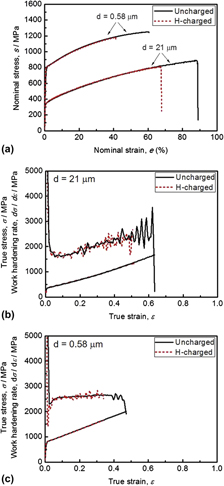Crossref Citations
This article has been cited by the following publications. This list is generated based on data provided by
Crossref.
Li, Xinfeng
Zhang, Jin
Fu, Qinqin
Akiyama, Eiji
Song, Xiaolong
Shen, Sicong
and
Li, Qizhen
2019.
Hydrogen embrittlement of high strength steam turbine last stage blade steels: Comparison between PH17-4 steel and PH13-8Mo steel.
Materials Science and Engineering: A,
Vol. 742,
Issue. ,
p.
353.
Koyama, Motomichi
Ichii, Kenshiro
and
Tsuzaki, Kaneaki
2019.
Grain refinement effect on hydrogen embrittlement resistance of an equiatomic CoCrFeMnNi high-entropy alloy.
International Journal of Hydrogen Energy,
Vol. 44,
Issue. 31,
p.
17163.
Tsuji, Nobuhiro
Gholizadeh, Reza
Ueji, Rintaro
Kamikawa, Naoya
Zhao, Lijia
Tian, Yanzhong
Bai, Yu
and
Shibata, Akinobu
2019.
Formation Mechanism of Ultrafine Grained Microstructures: Various Possibilities for Fabricating Bulk Nanostructured Metals and Alloys.
MATERIALS TRANSACTIONS,
Vol. 60,
Issue. 8,
p.
1518.
Bal, Burak
Çetin, Barış
Bayram, Ferdi Caner
and
Billur, Eren
2020.
Effect of hydrogen on fracture locus of Fe–16Mn–0.6C–2.15Al TWIP steel.
International Journal of Hydrogen Energy,
Vol. 45,
Issue. 58,
p.
34227.
Mweta, F. J.
Adachi, N.
Todaka, Y.
Sato, H.
Miura, H.
Kobayashi, M.
Watanabe, C.
and
Aoyagi, Y.
2021.
Effect of hetero- and homo-nanostructure on the hydrogen embrittlement resistance in heavily deformed 316LN austenitic stainless steel.
MRS Advances,
Vol. 6,
Issue. 27,
p.
682.
Tsuji, Nobuhiro
Shimokawa, Tomotsugu
Shizawa, Kazuyuki
and
Murayama, Mitsuhiro
2021.
Realizing Structural Metallic Materials with Both High Strength and Large Ductility through Nucleation Control of Different Deformation Modes.
Materia Japan,
Vol. 60,
Issue. 1,
p.
8.
Wang, Haoyu
Koyama, Motomichi
Hojo, Tomohiko
and
Akiyama, Eiji
2021.
Hydrogen embrittlement and associated surface crack growth in fine-grained equiatomic CoCrFeMnNi high-entropy alloys with different annealing temperatures evaluated by tensile testing under in situ hydrogen charging.
International Journal of Hydrogen Energy,
Vol. 46,
Issue. 65,
p.
33028.
Bai, Yu
Kitamura, Hiroki
Gao, Si
Tian, Yanzhong
Park, Nokeun
Park, Myeong-heom
Adachi, Hiroki
Shibata, Akinobu
Sato, Masugu
Murayama, Mitsuhiro
and
Tsuji, Nobuhiro
2021.
Unique transition of yielding mechanism and unexpected activation of deformation twinning in ultrafine grained Fe-31Mn-3Al-3Si alloy.
Scientific Reports,
Vol. 11,
Issue. 1,
Tsuji, Nobuhiro
2022.
Encyclopedia of Materials: Metals and Alloys.
p.
223.
Panchenko, M. Yu.
Nifontov, A. S.
and
Astafurova, E. G.
2022.
Microstructural Effect on Hydrogen Embrittlement of High Nitrogen Chromium-Manganese Steel.
Physical Mesomechanics,
Vol. 25,
Issue. 5,
p.
453.
Tsuji, Nobuhiro
Ogata, Shigenobu
Inui, Haruyuki
Tanaka, Isao
and
Kishida, Kyosuke
2022.
The Plaston Concept.
p.
3.
Edalati, Kaveh
Bachmaier, Andrea
Beloshenko, Victor A.
Beygelzimer, Yan
Blank, Vladimir D.
Botta, Walter J.
Bryła, Krzysztof
Čížek, Jakub
Divinski, Sergiy
Enikeev, Nariman A.
Estrin, Yuri
Faraji, Ghader
Figueiredo, Roberto B.
Fuji, Masayoshi
Furuta, Tadahiko
Grosdidier, Thierry
Gubicza, Jenő
Hohenwarter, Anton
Horita, Zenji
Huot, Jacques
Ikoma, Yoshifumi
Janeček, Miloš
Kawasaki, Megumi
Král, Petr
Kuramoto, Shigeru
Langdon, Terence G.
Leiva, Daniel R.
Levitas, Valery I.
Mazilkin, Andrey
Mito, Masaki
Miyamoto, Hiroyuki
Nishizaki, Terukazu
Pippan, Reinhard
Popov, Vladimir V.
Popova, Elena N.
Purcek, Gencaga
Renk, Oliver
Révész, Ádám
Sauvage, Xavier
Sklenicka, Vaclav
Skrotzki, Werner
Straumal, Boris B.
Suwas, Satyam
Toth, Laszlo S.
Tsuji, Nobuhiro
Valiev, Ruslan Z.
Wilde, Gerhard
Zehetbauer, Michael J.
and
Zhu, Xinkun
2022.
Nanomaterials by severe plastic deformation: review of historical developments and recent advances.
Materials Research Letters,
Vol. 10,
Issue. 4,
p.
163.
Kobayashi, Naohiro
Koyama, Motomichi
Yamamura, Misaho
Hojo, Tomohiko
and
Akiyama, Eiji
2022.
Cr Effects on the Local Plasticity Evolution and Fracture Behaviors of Ni-Cr Alloys Tensile-Tested under Hydrogen Charging.
Journal of the Japan Institute of Metals and Materials,
Vol. 86,
Issue. 5,
p.
77.
Koyama, Motomichi
2022.
Encyclopedia of Materials: Metals and Alloys.
p.
95.
Cuamatzi-Meléndez, Ruben
Martinez, Melchor Salazar
Bravo, Sergio Dionicio
and
Mendoza, Adán Ruiz
2023.
Cleavage Micromechanisms Study in a Ship Plate Steel through Four-Point Double-Notch Bend and Charpy Tests.
Key Engineering Materials,
Vol. 944,
Issue. ,
p.
13.
Kwon, Kyo-Min
Park, Tak-Min
Han, Jeongho
Kim, Hye-Jin
Fujii, Hidetoshi
and
Lee, Seung-Joon
2023.
The effect of friction-stir welding in hydrogen embrittlement of Fe-17Mn alloy.
Journal of Alloys and Compounds,
Vol. 967,
Issue. ,
p.
171720.
Sun, Binhan
Dong, Xizhen
Wen, Jianfeng
Zhang, Xian‐Cheng
and
Tu, Shan‐Tung
2023.
Microstructure design strategies to mitigate hydrogen embrittlement in metallic materials.
Fatigue & Fracture of Engineering Materials & Structures,
Vol. 46,
Issue. 8,
p.
3060.
Kim, Dong-Han
Moallemi, Mohammad
Kim, Kyung-Shik
Cho, Hyung-Jun
and
Kim, Sung-Joon
2023.
Correlation between grain size variation and hydrogen embrittlement in a cost-effective Fe40Mn40Ni10Cr10 austenitic medium entropy alloy.
International Journal of Hydrogen Energy,
Vol. 48,
Issue. 14,
p.
5708.
Liu, Hongzhi
Wang, Xiaozhen
Cui, Jingkai
Deng, Wei
and
Yang, Chao
2023.
Study on failure evolution of 15CrMo steel used for aviation kerosene hydrogenation unit.
Materials Research Express,
Vol. 10,
Issue. 5,
p.
056509.
Kobayashi, Naohiro
Koyama, Motomichi
Yamamura, Misaho
Hojo, Tomohiko
and
Akiyama, Eiji
2023.
Cr Effects on the Local Plasticity Evolution and Fracture Behaviors of Ni–Cr Alloys Tensile-Tested under Hydrogen Charging.
MATERIALS TRANSACTIONS,
Vol. 64,
Issue. 1,
p.
212.






